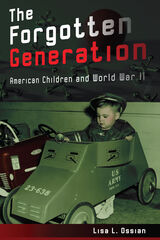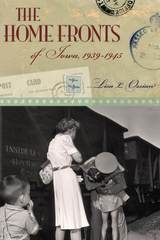3 books about Ossian, Lisa L.

The Depression Dilemmas of Rural Iowa, 1929-1933
Lisa L. Ossian
University of Missouri Press, 2012
To many rural Iowans, the stock market crash on New York’s Wall Street in October 1929 seemed an event far removed from their lives, even though the effects of the crash became all too real throughout the state. From 1929 to 1933, the enthusiastic faith that most Iowans had in Iowan President Herbert Hoover was transformed into bitter disappointment with the federal government. As a result, Iowans directly questioned their leadership at the state, county, and community levels with a renewed spirit to salvage family farms, demonstrating the uniqueness of Iowa’s rural life.
Beginning with an overview of the state during 1929, Lisa L. Ossian describes Iowa’s particular rural dilemmas, evoking, through anecdotes and examples, the economic, nutritional, familial, cultural, industrial, criminal, legal, and political challenges that engaged the people of the state. The following chapters analyze life during the early Depression: new prescriptions for children’s health, creative housekeeping to stretch resources, the use of farm “playlets” to communicate new information creatively and memorably, the demise of the soft coal mining industry, increased violence within the landscape, and the movement to end Prohibition.
The challenges faced in the early Great Depression years between 1929 and 1933 encouraged resourcefulness rather than passivity, creativity rather than resignation, and community rather than hopelessness. Of particular interest is the role of women within the rural landscape, as much of the increased daily work fell to farm women during this time. While the women addressed this work simply as “making do,” Ossian shows that their resourcefulness entailed complex planning essential for families’ emotional and physical health.
Ossian’s epilogue takes readers into the Iowa of today, dominated by industrial agriculture, and asks the reader to consider if this model that stemmed from Depression-era innovation is sustainable. Her rich rural history not only helps readers understand the particular forces at work that shaped the social and physical landscape of the past but also traces how these landscapes have continued in various forms for almost eighty years into this century.
[more]

The Forgotten Generation
American Children and World War II
Lisa L. Ossian
University of Missouri Press, 2011
Two days after the attack on Pearl Harbor, President Roosevelt addressed the nation by radio, saying, “We are all in it—all the way. Every single man, woman, and child is a partner in the most tremendous undertaking of our American history.” So began a continuing theme of the World War II years: the challenges of wartime would not be borne by adults alone. Men, women, and children would all be involved in the work of war.
The struggles endured by American civilians during the Second World War are well documented, but accounts of the war years have mostly deliberated on the grown-ups’ sacrifices. In The Forgotten Generation: American Children and World War II, Lisa L. Ossian explores the war’s full implications for the lives of children. In thematic chapters, the author delves into children’s experiences of family, school, play, work, and home, uncovering the range of effects the war had on youths of various ethnicities and backgrounds.
Since the larger U.S. culture so fervently supported the war effort, adults rarely sheltered children from the realities of the war and the trials of life on the home front. Children listened for news of battles over the radio, labored in munitions factories, and saved money for war bonds. They watched enlisted men—their fathers, uncles, and brothers—leave for duty and worried about the safety of soldiers overseas. They prayed during the D-Day invasion, mourned President Roosevelt’s death, and celebrated on V-J Day . . . all at an age when such sharp events are so difficult to understand. Ossian draws from a multitude of sources, including the writings of 1940s children, to demonstrate the great extent of these young people’s participation in the wartime culture.
World War II transformed a generation of youths as no other experience of the twentieth century would, but somehow the children at home during the war—compressed between the “Greatest Generation” and the “Baby Boomers”—slipped into the margins of U.S. history. The Forgotten Generation: American Children and World War II remembers these children and their engagement in “the most tremendous undertaking” that the war effort came to be. By bringing the depth of those experiences to light, Ossian makes a compelling contribution to the literature on American childhood and the research on this remarkable period of U.S. history.
[more]

The Home Fronts of Iowa, 1939-1945
Lisa L. Ossian
University of Missouri Press, 2009
As Americans geared up for World War II, each state responded according to its economy and circumstances—as well as the disposition of its citizens. This book considers the war years in Iowa by looking at activity on different home fronts and analyzing the resilience of Iowans in answering the call to support the war effort.
With its location in the center of the country, far from potentially threatened coasts, Iowa was also the center of American isolationism—historically Republican and resistant to involvement in another European war. Yet Iowans were quick to step up, and Lisa Ossian draws on historical archives as well as on artifacts of popular culture to record the rhetoric and emotion of their support.
Ossian shows how Iowans quickly moved from skepticism to overwhelming enthusiasm for the war and answered the call on four fronts: farms, factories, communities, and kitchens. Iowa’s farmers faced labor and machinery shortages, yet produced record amounts of crops and animals—even at the expense of valuable topsoil. Ordnance plants turned out bombs and machine gun bullets. Meanwhile, communities supported war bond and scrap drives, while housewives coped with rationing, raised Victory gardens, and turned to home canning.
The Home Fronts of Iowa, 1939–1945 depicts real people and their concerns, showing the price paid in physical and mental exhaustion and notes the heavy toll exacted on Iowa’s sons who fell in battle. Ossian also considers the relevance of such issues as race, class, and gender—particularly the role of women on the home front and the recruitment of both women and blacks for factory work—taking into account a prevalent suspicion of ethnic groups by the state’s largely homogeneous population.
The fact that Iowans could become loyal citizen soldiers—forming an Industrial and Defense Commission even before Pearl Harbor—speaks not only to the patriotism of these sturdy midwesterners but also to the overall resilience of Americans. In unraveling how Iowans could so overwhelmingly support the war, Ossian digs deep into history to show us the power of emotion—and to help us better understand why World War II is consistently remembered as “the Good War.”
[more]
READERS
Browse our collection.
PUBLISHERS
See BiblioVault's publisher services.
STUDENT SERVICES
Files for college accessibility offices.
UChicago Accessibility Resources
home | accessibility | search | about | contact us
BiblioVault ® 2001 - 2024
The University of Chicago Press









